Comparison of Satellite Precipitation Products: IMERG and GSMaP with Rain Gauge Observations in Northern China
Abstract
1. Introduction
2. Materials and Methods
2.1. Study Area
2.2. Datasets
2.2.1. Rain Gauge Observations
2.2.2. Satellite Data
2.2.3. Initial Processing
2.3. Statistics Metrics
3. Results
3.1. Accumulated Rainfall
3.2. Mean Hourly Rainfall
3.3. Contingency Information
4. Discussion
5. Conclusions
- (1)
- Spatially, IMERG products outperform GSMaP products because the strong precipitation centers captured by IMERG products are highly consistent with the observations, especially in extreme precipitation events in areas with relatively flat terrain and low-altitude (≤1000 m). When compared to the GSMaP products during the three extreme rainstorms, the IMERG products consistently had greater CCs, lower RBs, and RMSEs. Also, IMERG products are better at capturing the spatial distribution of precipitation.
- (2)
- Temporally, GSMaP satellite-based QPE products capture most precipitation peaks but significantly overestimate actual precipitation intensity, whereas IMERG satellite-based QPE products have a better fit with actual precipitation. At the same time, four satellite-based QPE products underestimate (overestimate) precipitation when the actual precipitation is heavy (light). In the comprehensive analysis, the IMERG_LR performs best, as it has the highest CCs (0.92, 0.88 and 0.81), lower RBs (0.12%, −0.01% and 0.18%) and RMSEs (0.24 mm, 0.24 mm, and 0.22 mm), whether in typhoon or non-typhoon extreme precipitation events.
- (3)
- In terms of POD, CSI, and FAR performance in extreme precipitation events, the GSMaP products perform more effectively in non-typhoon extreme precipitation events (12 July NCER and 5 October NCER), whereas IMERG products behave well in typhoon extreme precipitation events (20 July NCER). GSMaP satellite-based QPE products outperform IMERG satellite-based QPE products in estimating the precipitation of short-term rainstorm events.
Author Contributions
Funding
Informed Consent Statement
Data Availability Statement
Acknowledgments
Conflicts of Interest
References
- Du, H.; Alexander, L.V.; Donat, M.G.; Lippmann, T.; Srivastava, A.; Salinger, J.; Kruger, A.; Choi, G.; He, H.S.; Fujibe, F.; et al. Precipitation from Persistent Extremes Is Increasing in Most Regions and Globally. Geophys. Res. Lett. 2019, 46, 6041–6049. [Google Scholar] [CrossRef]
- Pfahl, S.; O’Gorman, P.A.; Fischer, E.M. Understanding the Regional Pattern of Projected Future Changes in Extreme Precipitation. Nat. Clim Chang. 2017, 7, 423–427. [Google Scholar] [CrossRef]
- Xinhuanet. Available online: http://www.xinhuanet.com/2021-07/10/c_1127642178.htm (accessed on 5 April 2022).
- CCTV Finance. Available online: https://baijiahao.baidu.com/s?id=1704703187597948625&wfr=spider&for=pc (accessed on 5 April 2022).
- Beijing News. Available online: https://www.bjnews.com.cn/detail/162747015314135.html (accessed on 5 April 2022).
- Economic and Commercial Office of the Embassy of the People’s Republic of China in Nepal. Available online: http://np.mofcom.gov.cn/article/jmxw/202107/20210703179528.shtml (accessed on 8 April 2022).
- China Science and Technology Network. Available online: http://stdaily.com/cehua/July12th/2021-07/12/content_1175867.shtml (accessed on 6 June 2022).
- Xu, H.; Duan, Y.; Li, Y.; Wang, H. Indirect Effects of Binary Typhoons on an Extreme Rainfall Event in Henan Province, China From 19 to 21 July 2021: 2. Numerical Study. JGR Atmos. 2022, 127, e2021JD036083. [Google Scholar] [CrossRef]
- Nie, Y.; Sun, J. Moisture Sources and Transport for Extreme Precipitation Over Henan in July 2021. Geophys. Res. Lett. 2022, 49, e2021GL097446. [Google Scholar] [CrossRef]
- China Meteorological Administration. Available online: http://www.cma.gov.cn/2011xwzx/2011xqxxw/2011xzytq/202107/t20210721_581154.html (accessed on 6 June 2022).
- Beijing News. Available online: https://www.bjnews.com.cn/detail/162682885614771.html (accessed on 6 June 2022).
- Shanxi Meteorological Administration. Available online: http://sx.cma.gov.cn/gzdt/shjdt/202110/t20211014_3874296.html (accessed on 1 April 2022).
- Wang, H.; Shao, Z.; Gao, T.; Zou, T.; Liu, J.; Yuan, H. Extreme Precipitation Event over the Yellow Sea Western Coast: Is There a Trend? Quat. Int. 2017, 441, 1–17. [Google Scholar] [CrossRef]
- Chen, S.; Hong, Y.; Cao, Q.; Tian, Y.; Hu, J.; Zhang, X.; Li, W.; Carr, N.; Shen, X.; Qiao, L. Intercomparison of Precipitation Estimates from WSR-88D Radar and TRMM Measurement Over Continental United States. IEEE Trans. Geosci. Remote Sens. 2015, 53, 4444–4456. [Google Scholar] [CrossRef]
- Moazami, S.; Golian, S.; Hong, Y.; Sheng, C.; Kavianpour, M.R. Comprehensive Evaluation of Four High-Resolution Satellite Precipitation Products under Diverse Climate Conditions in Iran. Hydrol. Sci. J. 2016, 61, 420–440. [Google Scholar] [CrossRef]
- Guo, H.; Chen, S.; Bao, A.; Hu, J.; Yang, B.; Stepanian, P. Comprehensive Evaluation of High-Resolution Satellite-Based Precipitation Products over China. Atmosphere 2015, 7, 6. [Google Scholar] [CrossRef]
- Zhang, A.; Xiao, L.; Min, C.; Chen, S.; Kulie, M.; Huang, C.; Liang, Z. Evaluation of Latest GPM-Era High-Resolution Satellite Precipitation Products during the May 2017 Guangdong Extreme Rainfall Event. Atmos. Res. 2019, 216, 76–85. [Google Scholar] [CrossRef]
- Huang, C.; Hu, J.; Chen, S.; Zhang, A.; Liang, Z.; Tong, X.; Xiao, L.; Min, C.; Zhang, Z. How Well Can IMERG Products Capture Typhoon Extreme Precipitation Events over Southern China? Remote Sens. 2019, 11, 70. [Google Scholar] [CrossRef]
- Li, X.; Chen, S.; Liang, Z.; Huang, C.; Li, Z.; Hu, B. Performance Assessment of GSMaP and GPM IMERG Products during Typhoon Mangkhut. Atmosphere 2021, 12, 134. [Google Scholar] [CrossRef]
- Chen, S.; Hu, J.; Zhang, A.; Min, C.; Huang, C.; Liang, Z. Performance of near Real-Time Global Satellite Mapping of Precipitation Estimates during Heavy Precipitation Events over Northern China. Theor. Appl. Climatol. 2019, 135, 877–891. [Google Scholar] [CrossRef]
- Chen, H.; Yong, B.; Qi, W.; Wu, H.; Ren, L.; Hong, Y. Investigating the Evaluation Uncertainty for Satellite Precipitation Estimates Based on Two Different Ground Precipitation Observation Products. J. Hydrometeorol. 2020, 21, 2595–2606. [Google Scholar] [CrossRef]
- Guo, H.; Chen, S.; Bao, A.; Behrangi, A.; Hong, Y.; Ndayisaba, F.; Hu, J.; Stepanian, P.M. Early Assessment of Integrated Multi-Satellite Retrievals for Global Precipitation Measurement over China. Atmos. Res. 2016, 176–177, 121–133. [Google Scholar] [CrossRef]
- Gebregiorgis, A.S.; Kirstetter, P.; Hong, Y.E.; Gourley, J.J.; Huffman, G.J.; Petersen, W.A.; Xue, X.; Schwaller, M.R. To What Extent Is the Day 1 GPM IMERG Satellite Precipitation Estimate Improved as Compared to TRMM TMPA-RT? J. Geophys. Res. Atmos. 2018, 123, 1694–1707. [Google Scholar] [CrossRef]
- Vicente, G.A.; Scofield, R.A.; Menzel, W.P. The Operational GOES Infrared Rainfall Estimation Technique. Bull. Am. Meteorol. Soc. 1998, 79, 1883–1898. [Google Scholar] [CrossRef]
- Tan, J.; Huffman, G.J.; Bolvin, D.T.; Nelkin, E.J. IMERG V06: Changes to the Morphing Algorithm. J. Atmos. Ocean. Technol. 2019, 36, 2471–2482. [Google Scholar] [CrossRef]
- Dinku, T.; Ceccato, P.; Grover-Kopec, E.; Lemma, M.; Connor, S.J.; Ropelewski, C.F. Validation of Satellite Rainfall Products over East Africa’s Complex Topography. Int. J. Remote Sens. 2007, 28, 1503–1526. [Google Scholar] [CrossRef]
- Liu, M.; Xu, X.; Sun, A.Y.; Wang, K.; Yue, Y.; Tong, X.; Liu, W. Evaluation of High-Resolution Satellite Rainfall Products Using Rain Gauge Data over Complex Terrain in Southwest China. Theor. Appl. Climatol. 2015, 119, 203–219. [Google Scholar] [CrossRef]
- Hirpa, F.A.; Gebremichael, M.; Hopson, T. Evaluation of High-Resolution Satellite Precipitation Products over Very Complex Terrain in Ethiopia. J. Appl. Meteorol. Climatol. 2010, 49, 1044–1051. [Google Scholar] [CrossRef]
- Yong, B.; Hong, Y.; Ren, L.-L.; Gourley, J.J.; Huffman, G.J.; Chen, X.; Wang, W.; Khan, S.I. Assessment of Evolving TRMM-Based Multisatellite Real-Time Precipitation Estimation Methods and Their Impacts on Hydrologic Prediction in a High Latitude Basin: Satellite rainfall hydrologic evaluation. J. Geophys. Res. Atmos. 2012, 117, D09108. [Google Scholar] [CrossRef]
- Tian, Y.; Peters-Lidard, C.D.; Eylander, J.B.; Joyce, R.J.; Huffman, G.J.; Adler, R.F.; Hsu, K.; Turk, F.J.; Garcia, M.; Zeng, J. Component Analysis of Errors in Satellite-Based Precipitation Estimates. J. Geophys. Res. 2009, 114, D24101. [Google Scholar] [CrossRef]
- Kirstetter, P.-E.; Hong, Y.; Gourley, J.J.; Schwaller, M.; Petersen, W.; Zhang, J. Comparison of TRMM 2A25 Products, Version 6 and Version 7, with NOAA/NSSL Ground Radar–Based National Mosaic QPE. J. Hydrometeorol. 2013, 14, 661–669. [Google Scholar] [CrossRef]
- Chen, H.; Yong, B.; Shen, Y.; Liu, J.; Hong, Y.; Zhang, J. Comparison Analysis of Six Purely Satellite-Derived Global Precipitation Estimates. J. Hydrol. 2020, 581, 124376. [Google Scholar] [CrossRef]
- Zhang, M.; Chen, S.; Qi, Y.C.; Yang, Y. Evaluation of TRMM Summer Precipitation over Huai-River Basin in China. Adv. Mater. Res. 2013, 726–731, 3401–3406. [Google Scholar] [CrossRef]
- Kim, K.; Park, J.; Baik, J.; Choi, M. Evaluation of Topographical and Seasonal Feature Using GPM IMERG and TRMM 3B42 over Far-East Asia. Atmos. Res. 2017, 187, 95–105. [Google Scholar] [CrossRef]
- Chen, S.; Behrangi, A.; Tian, Y.; Hu, J.; Hong, Y.; Tang, Q.; Hu, X.-M.; Stepanian, P.M.; Hu, B.; Zhang, X. Precipitation Spectra Analysis Over China with High-Resolution Measurements from Optimally-Merged Satellite/Gauge Observations—Part II: Diurnal Variability Analysis. IEEE J. Sel. Top. Appl. Earth Obs. Remote Sens. 2016, 9, 2979–2988. [Google Scholar] [CrossRef]
- Aslami, F.; Ghorbani, A.; Sobhani, B.; Esmali, A. Comprehensive comparison of daily IMERG and GSMaP satellite precipitation products in Ardabil Province, Iran. Int. J. Remote Sens. 2018, 40, 3139–3153. [Google Scholar] [CrossRef]
- Nascimento, J.G.; Althoff, D.; Bazame, H.C.; Neale, C.M.U.; Duarte, S.N.; Ruhoff, A.L.; Gonçalves, I.Z. Evaluating the Latest IMERG Products in a Subtropical Climate: The Case of Paraná State, Brazil. Remote Sens. 2021, 13, 906. [Google Scholar] [CrossRef]
- Sharma, S.; Chen, Y.; Zhou, X.; Yang, K.; Li, X.; Niu, X.; Hu, X.; Khadka, N. Evaluation of GPM-Era Satellite Precipitation Products on the Southern Slopes of the Central Himalayas Against Rain Gauge Data. Remote Sens. 2020, 12, 1836. [Google Scholar] [CrossRef]
- Nwachukwu, P.N.; Satge, F.; Yacoubi, S.E.; Pinel, S.; Bonnet, M.-P. From TRMM to GPM: How Reliable Are Satellite-Based Precipitation Data across Nigeria? Remote Sens. 2020, 12, 3964. [Google Scholar] [CrossRef]
- Sharma, S.; Khadka, N.; Hamal, K.; Shrestha, D.; Talchabhadel, R.; Chen, Y. How Accurately Can Satellite Products (TMPA and IMERG) Detect Precipitation Patterns, Extremities, and Drought Across the Nepalese Himalaya? Earth Space Sci. 2020, 7, e2020EA001315. [Google Scholar] [CrossRef]
- Ramadhan, R.; Yusnaini, H.; Marzuki, M.; Muharsyah, R.; Suryanto, W.; Sholihun, S.; Vonnisa, M.; Harmadi, H.; Ningsih, A.P.; Battaglia, A.; et al. Evaluation of GPM IMERG Performance Using Gauge Data over Indonesian Maritime Continent at Different Time Scales. Remote Sens. 2022, 14, 1172. [Google Scholar] [CrossRef]
- Pratama, A.; Agiel, H.M.; Oktaviana, A.A. Evaluasi Satellite Precipitation Product (GSMaP, CHIRPS, dan IMERG) di Kabupaten Lampung Selatan. J. Sci. Appl. Technol. 2022, 6, 32. [Google Scholar] [CrossRef]
- Veloria, A.; Perez, G.J.; Tapang, G.; Comiso, J. Improved Rainfall Data in the Philippines through Concurrent Use of GPM IMERG and Ground-Based Measurements. Remote Sens. 2021, 13, 2859. [Google Scholar] [CrossRef]
- Darand, M.; Siavashi, Z. An Evaluation of Global Satellite Mapping of Precipitation (GSMaP) Datasets over Iran. Meteorol. Atmos. Phys. 2021, 133, 911–923. [Google Scholar] [CrossRef]
- Tashima, T.; Kubota, T.; Mega, T.; Ushio, T.; Oki, R. Precipitation Extremes Monitoring Using the Near-Real-Time GSMaP Product. IEEE J. Sel. Top. Appl. Earth Obs. Remote Sens. 2020, 13, 5640–5651. [Google Scholar] [CrossRef]
- Chua, Z.-W.; Kuleshov, Y.; Watkins, A.B.; Choy, S.; Sun, C. A Two-Step Approach to Blending GSMaP Satellite Rainfall Estimates with Gauge Observations over Australia. Remote Sens. 2022, 14, 1903. [Google Scholar] [CrossRef]
- Wei, G.; Lü, H.; Crow, W.T.; Zhu, Y.; Su, J.; Ren, L. Comprehensive Evaluation and Error-Component Analysis of Four Satellite-Based Precipitation Estimates against Gauged Rainfall over Mainland China. Adv. Meteorol. 2022, 2022, 1–29. [Google Scholar] [CrossRef]
- Zhou, Z.; Guo, B.; Xing, W.; Zhou, J.; Xu, F.; Xu, Y. Comprehensive Evaluation of Latest GPM Era IMERG and GSMaP Precipitation Products over Mainland China. Atmos. Res. 2020, 246, 105132. [Google Scholar] [CrossRef]
- Xu, S.; Shen, Y.; Niu, Z. Evaluation of the IMERG Version 05B Precipitation Product and Comparison with IMERG Version 04A over Mainland China at Hourly and Daily Scales. Adv. Space Res. 2019, 63, 2387–2398. [Google Scholar] [CrossRef]
- Li, X.; Chen, Y.; Wang, H.; Zhang, Y. Assessment of GPM IMERG and Radar Quantitative Precipitation Estimation (QPE) Products Using Dense Rain Gauge Observations in the Guangdong-Hong Kong-Macao Greater Bay Area, China. Atmos. Res. 2020, 236, 104834. [Google Scholar] [CrossRef]
- Wang, H.; Yuan, Y.; Zeng, S.; Li, W.; Tang, X. Evaluation of Satellite-Based Precipitation Products from GPM IMERG and GSMaP over the Three-River Headwaters Region, China. Hydrol. Res. 2021, 52, 1328–1343. [Google Scholar] [CrossRef]
- Wang, Y.; Zhao, N. Evaluation of Eight High-Resolution Gridded Precipitation Products in the Heihe River Basin, Northwest China. Remote Sens. 2022, 14, 1458. [Google Scholar] [CrossRef]
- Shi, J.; Bao, Z.; Zhang, J.; Liu, C.; Jin, J.; Liu, Y.; Wang, G. Comparison of the Performance of IMERG Products and Interpolation-Based Precipitation Estimates in the Middle Reaches of Yellow River Basin. Water 2022, 14, 1503. [Google Scholar] [CrossRef]
- Sun, G.; Wei, Y.; Wang, G.; Shi, R.; Chen, H.; Mo, C. Downscaling Correction and Hydrological Applicability of the Three Latest High-Resolution Satellite Precipitation Products (GPM, GSMAP, and MSWEP) in the Pingtang Catchment, China. Adv. Meteorol. 2022, 2022, 1–23. [Google Scholar] [CrossRef]
- Ren, Z.; Wang, G.; Zou, F.; Zhang, H. The Research of Precipitation Measurement Errors in China. Acta Meteorol. Sin. 2003, 61, 621–627. [Google Scholar]
- Ren, Z.; Zhao, P.; Zhang, Q.; Zhang, Z.; Cao, L.; Yang, Y.; Zou, F.; Zhao, Y.; Zhao, H.; Chen, Z. Quality Control Procedures for Hourly Precipitation Data from Automatic Weather Stations in China. Meteorol. Mon. 2010, 36, 123–132. [Google Scholar]
- Xu, W.; Li, Q.; Wang, X.L.; Yang, S.; Cao, L.; Feng, Y. Homogenization of Chinese Daily Surface Air Temperatures and Analysis of Trends in the Extreme Temperature Indices. J. Geophys. Res. Atmos. 2013, 118, 9708–9720. [Google Scholar] [CrossRef]
- Chen, C.; Chen, Q.; Duan, Z.; Zhang, J.; Mo, K.; Li, Z.; Tang, G. Multiscale Comparative Evaluation of the GPM IMERG v5 and TRMM 3B42 v7 Precipitation Products from 2015 to 2017 over a Climate Transition Area of China. Remote Sens. 2018, 10, 944. [Google Scholar] [CrossRef]
- Huffman, G.J. Satellite Precipitation Measurement; Springer: Cham, Switzerland, 2020; Volume 67, pp. 343–353. [Google Scholar]
- Mega, T.; Ushio, T.; Takahiro, M.; Kubota, T.; Kachi, M.; Oki, R. Gauge-Adjusted Global Satellite Mapping of Precipitation. IEEE Trans. Geosci. Remote Sens. 2019, 57, 1928–1935. [Google Scholar] [CrossRef]
- Ushio, T.; Sasashige, K.; Kubota, T.; Shige, S.; Okamoto, K.; Aonashi, K.; Inoue, T.; Takahashi, N.; Iguchi, T.; Kachi, M.; et al. A Kalman Filter Approach to the Global Satellite Mapping of Precipitation (GSMaP) from Combined Passive Microwave and Infrared Radiometric Data. J. Meteorol. Soc. Jpn. 2009, 87A, 137–151. [Google Scholar] [CrossRef]
- Kubota, T.K.; Aonashi, T.; Ushio, S.; Shige, Y.N.; Takayabu, M.; Kachi, Y.; Arai, T.; Tashima, T.; Masaki, N.; Kawamoto, T.; et al. Satellite Precipitation Measurement; Springer: Cham, Switzerland, 2020; Volume 67, pp. 355–373. [Google Scholar]
- Prasad, M.S.G.; Sushma, N. Spatial Prediction of Rainfall using Universal Kriging Method: A Case Study of Mysuru District. Int. J. Eng. Res. Technol. Geospat. 2016, 4, 20010. [Google Scholar] [CrossRef]
- Seo, Y.; Kim, S.; Singh, V.P. Estimating Spatial Precipitation Using Regression Kriging and Artificial Neural Network Residual Kriging (RKNNRK) Hybrid Approach. Water Resour. Manag. 2015, 29, 2189–2204. [Google Scholar] [CrossRef]
- Ly, S.; Charles, C.; Degré, A. Different Methods for Spatial Interpolation of Rainfall Data for Operational Hydrology and Hydrological Modeling at Watershed Scale. A Review. Biotechnologie. Agronomie. Société Et Environ. 2013, 17, 392–406. [Google Scholar] [CrossRef]
- Oliver, M.A.; Webster, R. Kriging: A Method of Interpolation for Geographical Information Systems. Int. J. Geogr. Inf. Syst. 1990, 4, 313–332. [Google Scholar] [CrossRef]
- Ryu, J.-S.; Kim, M.-S.; Cha, K.-J.; Lee, T.H.; Choi, D.-H. Kriging Interpolation Methods in Geostatistics and DACE Model. KSME Int. J. 2002, 16, 619–632. [Google Scholar] [CrossRef]
- GB/T 28592—2012; Grade of Precipitation. Standards Press of China: Beijing, China, 2012; pp. 1–2.
- World Meteorological Organization. Chapter 14. In Guide to Meteorological Instruments and Methods of Observation, 7th ed.; WMO: Geneva, Switzerland, 2012; pp. I.14–I.19. [Google Scholar]
- Taylor, K.E. Summarizing Multiple Aspects of Model Performance in a Single Diagram. J. Geophys. Res. Atmos. 2001, 106, 7183–7192. [Google Scholar] [CrossRef]
- Ebert, E.E.; Janowiak, J.E.; Kidd, C. Comparison of Near-Real-Time Precipitation Estimates from Satellite Observations and Numerical Models. Bull. Am. Meteorol. Soc. 2007, 88, 47–64. [Google Scholar] [CrossRef]
- T/CMSA 0013—2019; The Grade of Rainfall in Short Time Weather Service. China Meteorological Service Association: Beijing, China, 2019; pp. 1–2.
- Chen, S.; Hong, Y.; Cao, Q.; Kirstetter, P.-E.; Gourley, J.J.; Qi, Y.; Zhang, J.; Howard, K.; Hu, J.; Wang, J. Performance Evaluation of Radar and Satellite Rainfalls for Typhoon Morakot over Taiwan: Are Remote-Sensing Products Ready for Gauge Denial Scenario of Extreme Events? J. Hydrol. 2013, 506, 4–13. [Google Scholar] [CrossRef]
- Tuttle, J.D.; Carbone, R.E.; Arkin, P.A. Comparison of Ground-Based Radar and Geosynchronous Satellite Climatologies of Warm-Season Precipitation over the United States. J. Appl. Meteorol. Climatol. 2008, 47, 3264–3270. [Google Scholar] [CrossRef]
- Sharifi, E.; Steinacker, R.; Saghafian, B. Assessment of GPM-IMERG and Other Precipitation Products against Gauge Data under Different Topographic and Climatic Conditions in Iran: Preliminary Results. Remote Sens. 2016, 8, 135. [Google Scholar] [CrossRef]
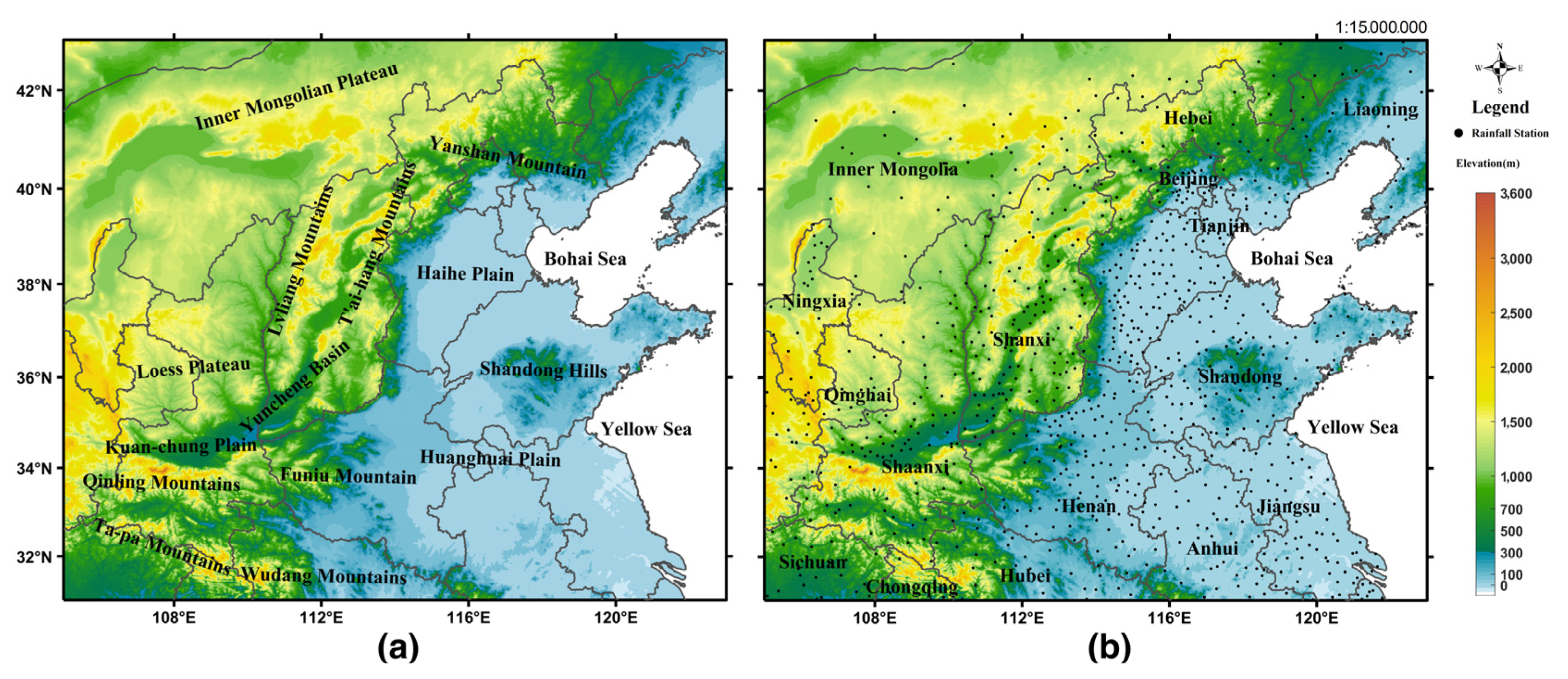
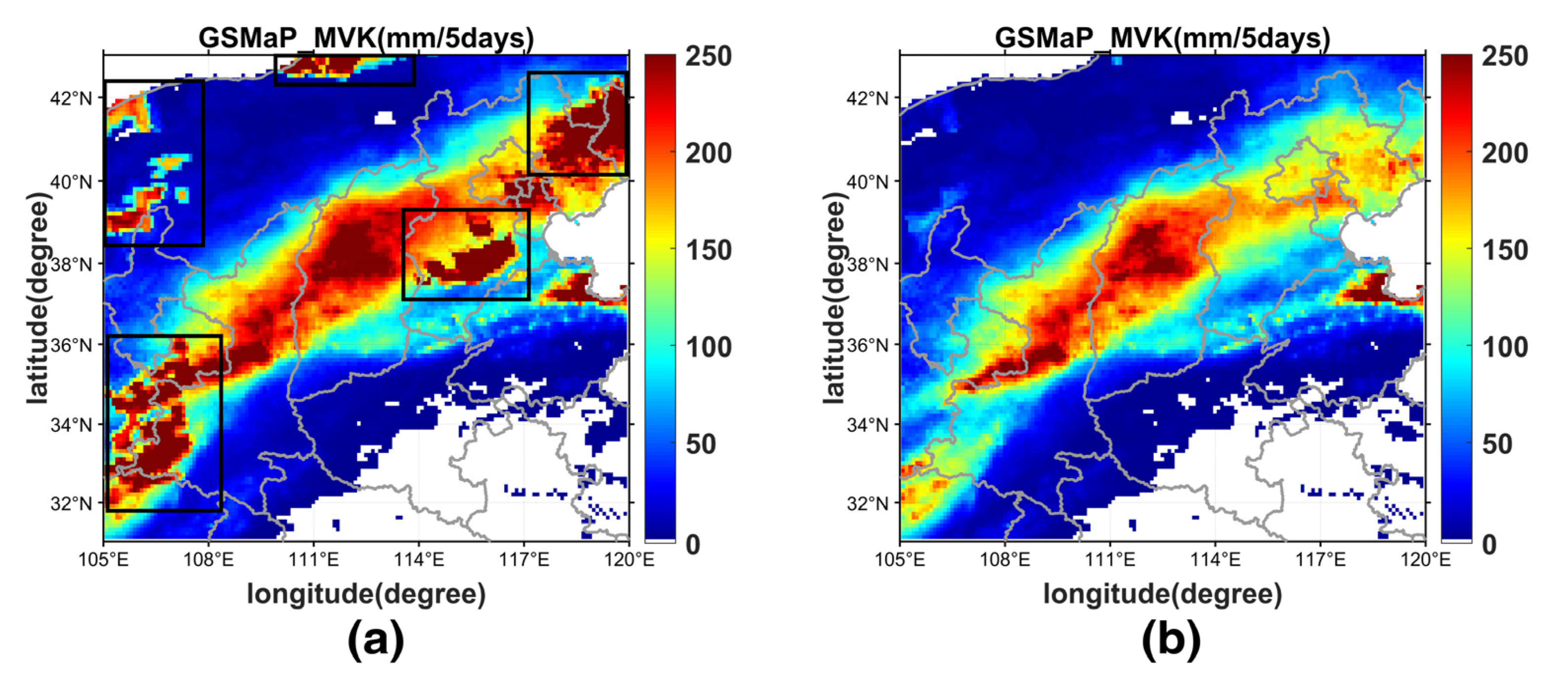
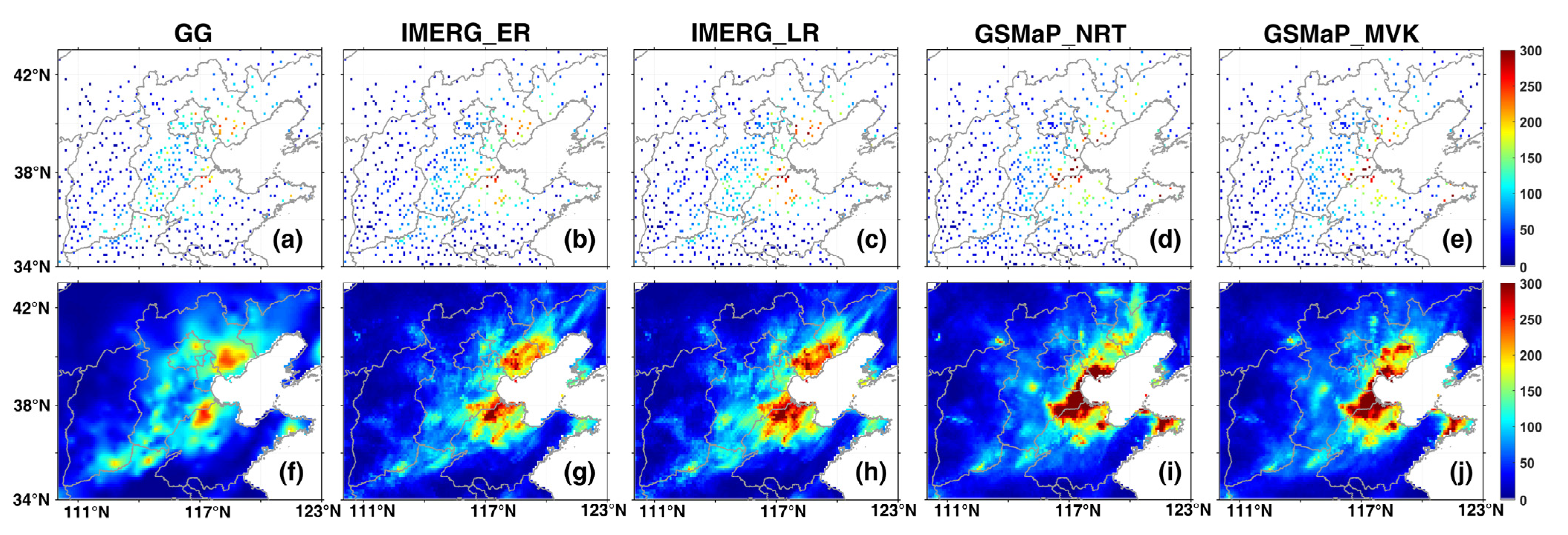
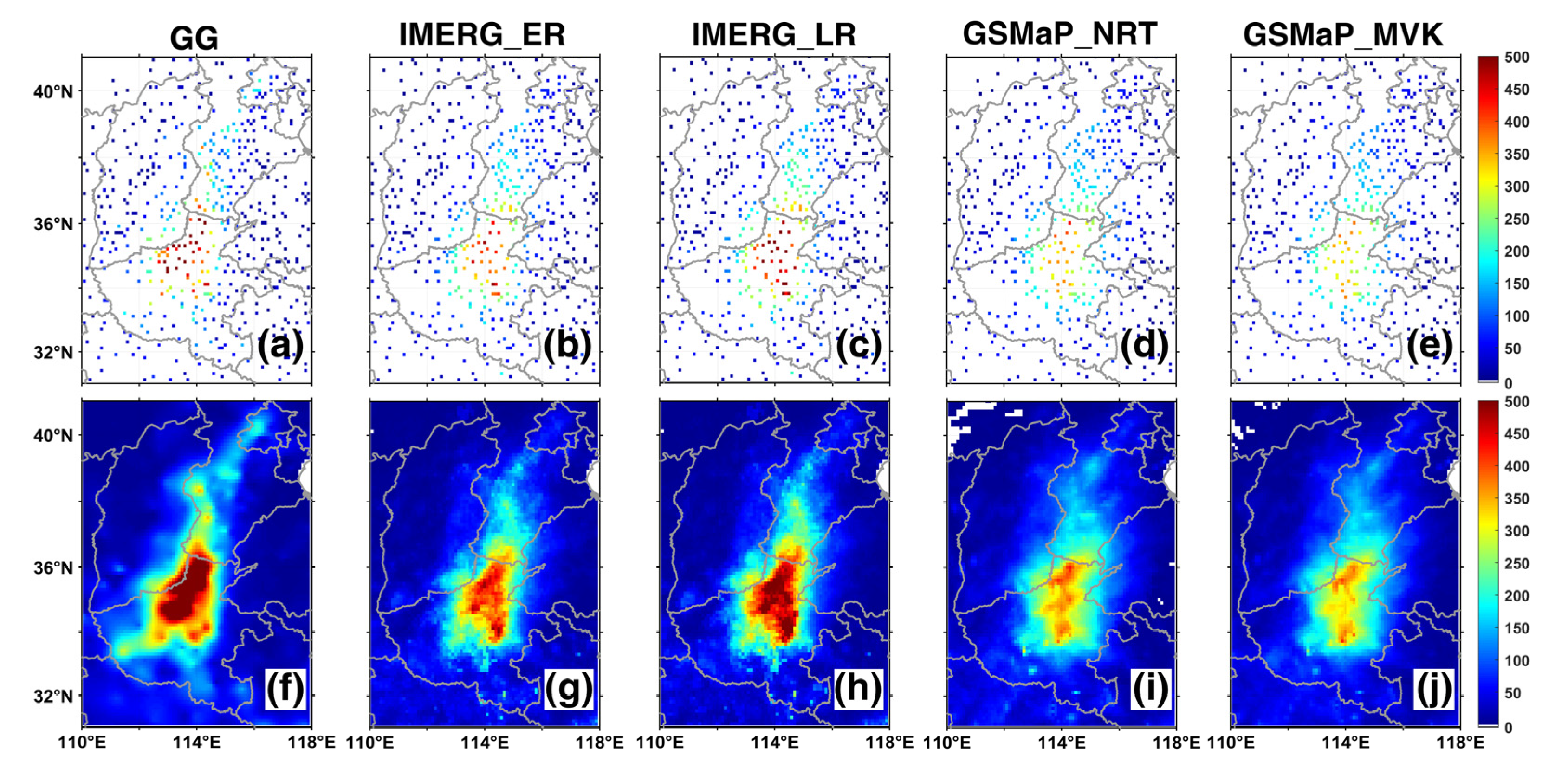
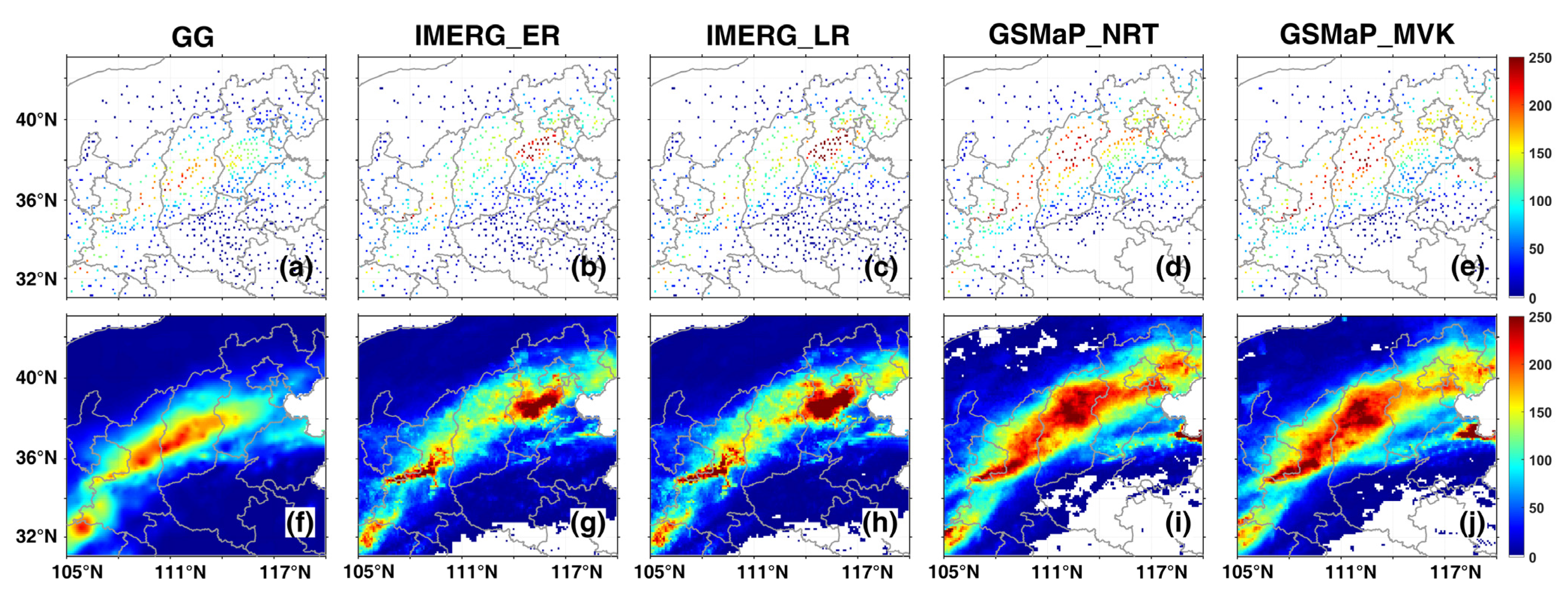
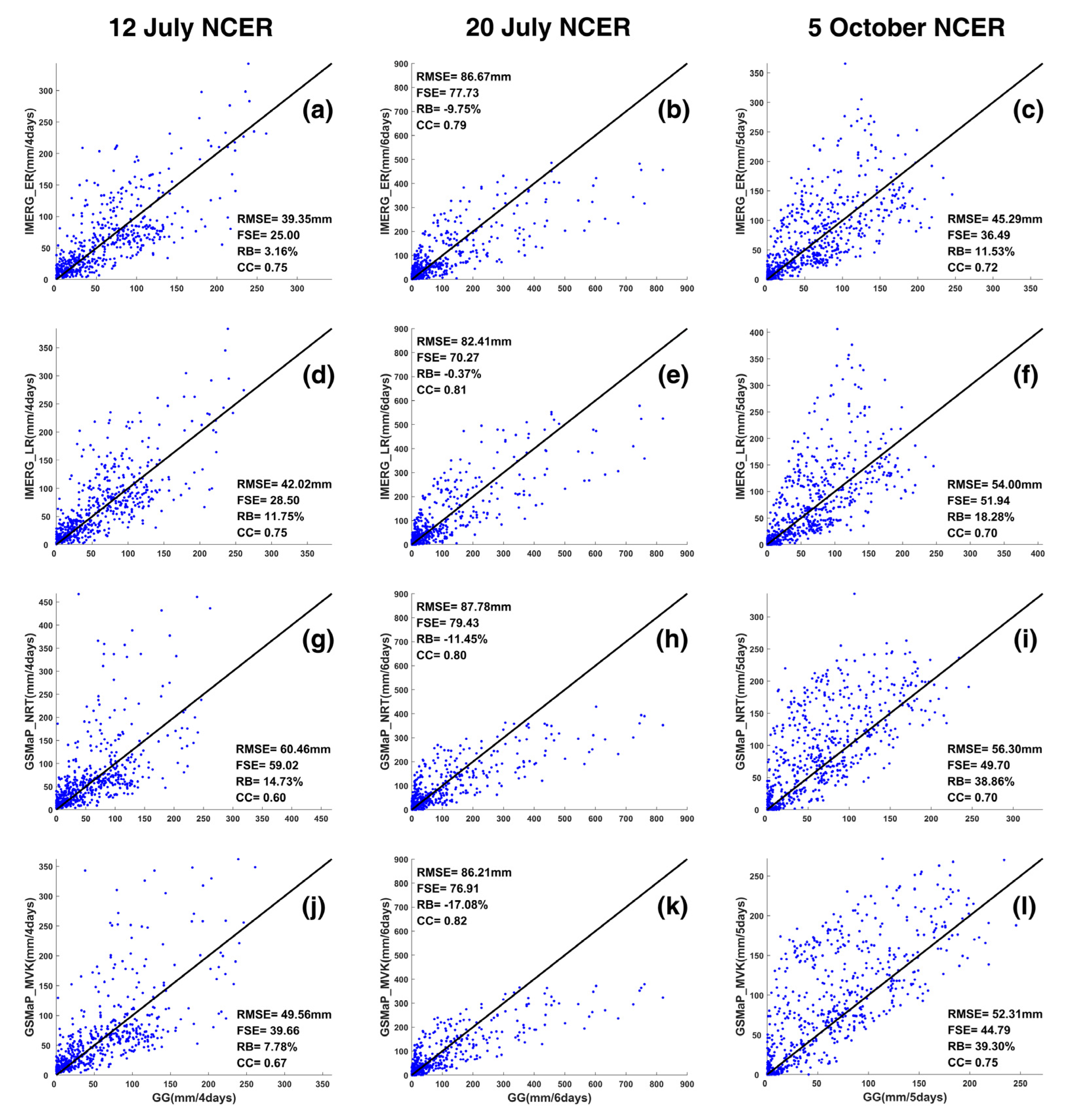
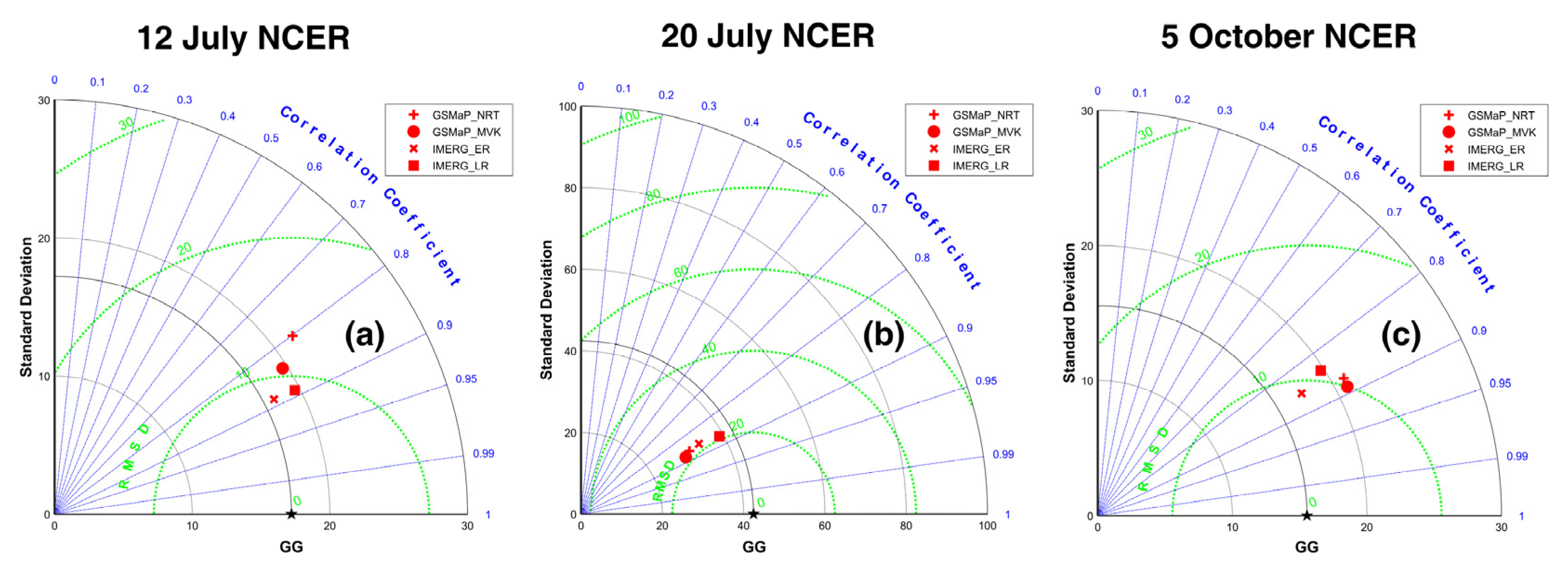
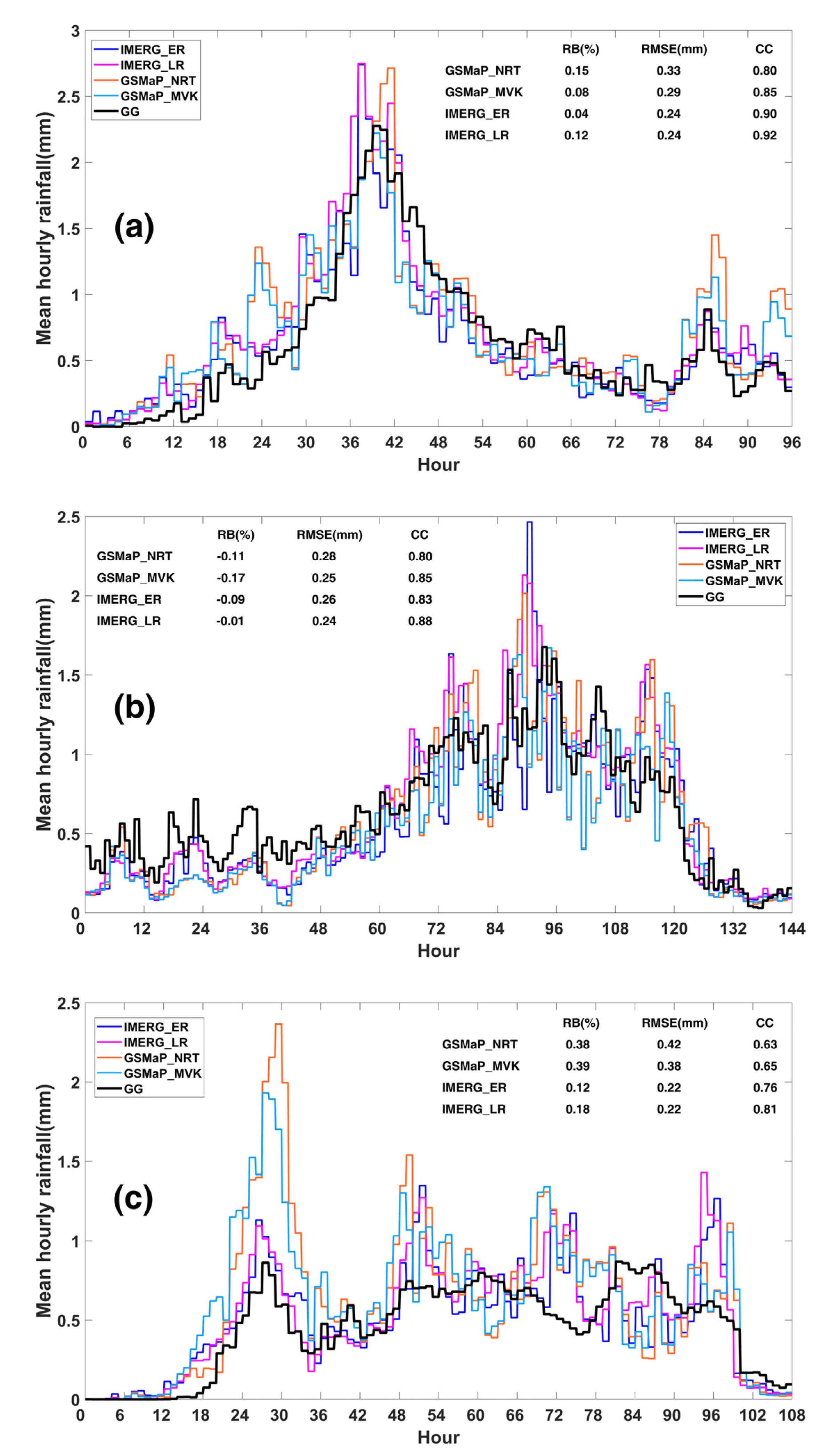
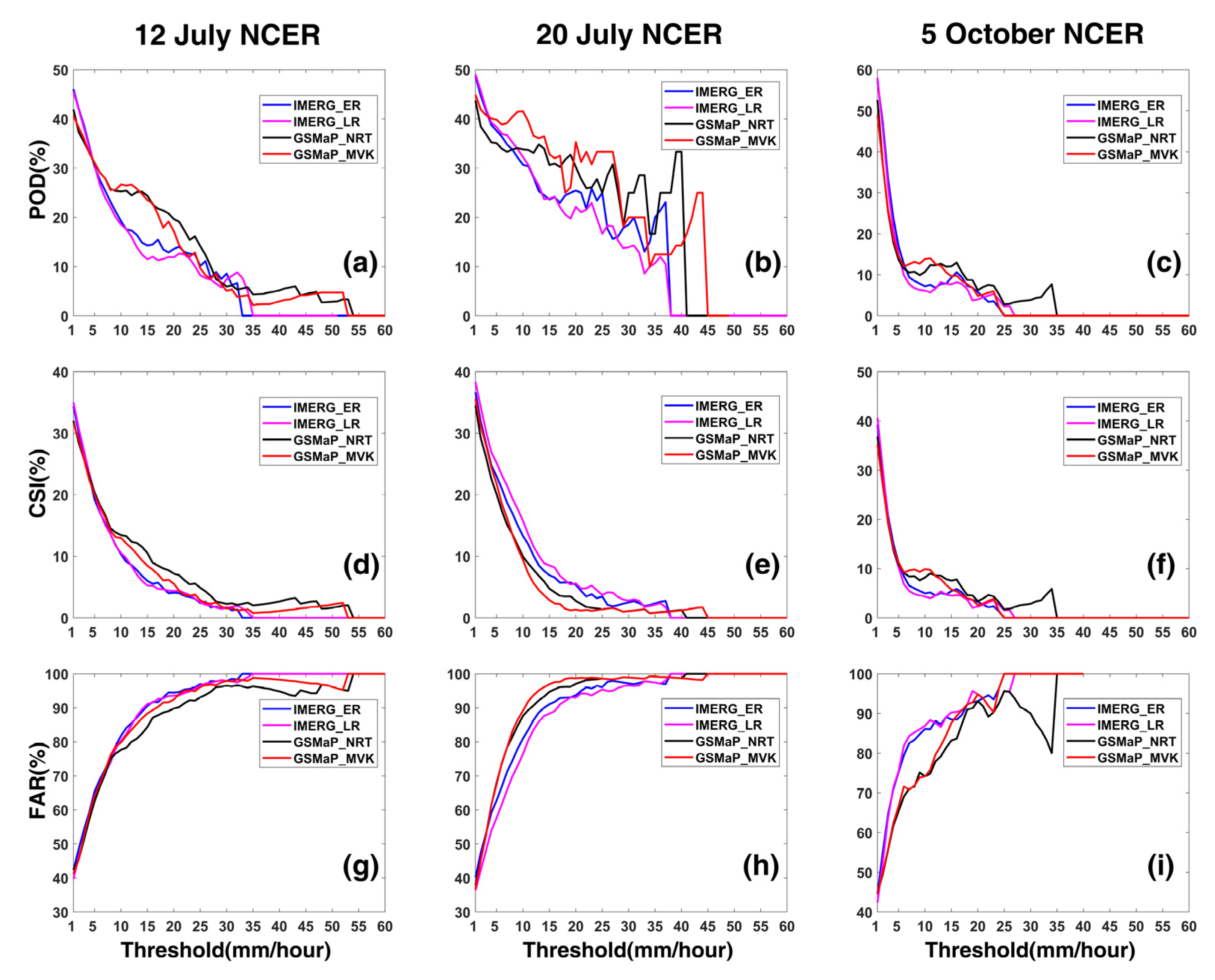
| Product | Spatial/ Temporal Resolution | Spatial Domain | Main Input Data | Latency | Applications |
|---|---|---|---|---|---|
| IMERG_ER | 0.1°/0.5 h | 90°N–90°S | PMW, DPR 1, GMI 2, PR 3, TMI 4, AMSR2 5, SSMIS 6 | 4 h | Prediction of flash floods and precipitation |
| IMERG_LR | 0.1°/0.5 h | 90°N–90°S | PMW, DPR, GMI, PR, TMI, AMSR2, SSMIS | 14 h | Water resource management |
| GSMaP_NRT | 0.1°/1 h | 60°N–60°S | TMI, GMI, SSMIS, PR, DPR, AMSU-A 7/AMSU-B 8 | 4 h | Real-time applications |
| GSMaP_MVK | 0.1°/1 h | 60°N–60°S | TMI, GMI, SSMIS, PR, DPR, AMSU-A/ AMSU-B | 3 days | Water resource management |
| Statistic Indices | Formula | Range | Optimum Value |
|---|---|---|---|
| Correlation Coefficient (CC) | [−1, 1] | 1 | |
| Relative Bias (RB) | (−∞, ∞) | 0 | |
| Root-Mean-Squared Error (RMSE) | [0, ∞) | 0 | |
| Fractional Standard Error (FSE) | [0, ∞) | 0 | |
| Probability of Detection (POD) | [0, 1] | 1 | |
| False Alarm Ration (FAR) | [0, 1] | 0 | |
| Critical Success Index (CSI) | [0, 1] | 1 |
| Precipitation Grade | Daily Precipitation (mm) |
|---|---|
| Light Rain | 1 ≤ i < 10 |
| Moderate Rain | 10 ≤ i < 25 |
| Heavy Rain | 25 ≤ i < 50 |
| Rainstorm | 50 ≤ i < 100 |
| Large Rainstorm | 100 ≤ i < 250 |
| Extraordinary Rainstorm | i ≥ 250 |
| Precipitation Grade | Daily Precipitation (mm) |
|---|---|
| Light Rain | i < 2.5 |
| Moderate Rain | 2.5 ≤ i < 10.0 |
| Heavy Rain | 10.0 ≤ i < 50.0 |
| Violent Rain | i ≥ 50.0 |
Publisher’s Note: MDPI stays neutral with regard to jurisdictional claims in published maps and institutional affiliations. |
© 2022 by the authors. Licensee MDPI, Basel, Switzerland. This article is an open access article distributed under the terms and conditions of the Creative Commons Attribution (CC BY) license (https://creativecommons.org/licenses/by/4.0/).
Share and Cite
Zhu, H.; Chen, S.; Li, Z.; Gao, L.; Li, X. Comparison of Satellite Precipitation Products: IMERG and GSMaP with Rain Gauge Observations in Northern China. Remote Sens. 2022, 14, 4748. https://doi.org/10.3390/rs14194748
Zhu H, Chen S, Li Z, Gao L, Li X. Comparison of Satellite Precipitation Products: IMERG and GSMaP with Rain Gauge Observations in Northern China. Remote Sensing. 2022; 14(19):4748. https://doi.org/10.3390/rs14194748
Chicago/Turabian StyleZhu, Huiqin, Sheng Chen, Zhi Li, Liang Gao, and Xiaoyu Li. 2022. "Comparison of Satellite Precipitation Products: IMERG and GSMaP with Rain Gauge Observations in Northern China" Remote Sensing 14, no. 19: 4748. https://doi.org/10.3390/rs14194748
APA StyleZhu, H., Chen, S., Li, Z., Gao, L., & Li, X. (2022). Comparison of Satellite Precipitation Products: IMERG and GSMaP with Rain Gauge Observations in Northern China. Remote Sensing, 14(19), 4748. https://doi.org/10.3390/rs14194748











